![]()
![]()
![]()
Use LEFT and RIGHT arrow keys to navigate between flashcards;
Use UP and DOWN arrow keys to flip the card;
H to show hint;
A reads text to speech;
30 Cards in this Set
- Front
- Back

|
ZIGGURAT AT UR Sumerianc. 2100 BCEThis structure supported a temple dedicated to the worship of the Patron god to the city of Ur, known as Nanna-sin (the moon god). The Sumerians believed Nanna-sin would be more likely to help & protect if they attempted to literally get closer to him. |
|
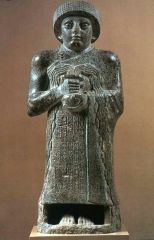
|
VOTIVE STATUE OF THE KING GUDEA Sumerian 2130 BCE A statue of a sumerian king named Gudea, designed to appeal to the gods by showing him as their humble servant. His people would see him as connected to the gods and therefor a leader likely to bring about prosperity and other advantages. Prayer by proxy - was used in his absence. ICONOGRAPHY: - Holding a vase from which water flows in 2 directions/water of life - Tigris & Euphrates rivers, which Sumer's agriculture depended on. - Inscription on robe dedicated to goddess Geshtinanna (goddess of dreams) to foretell outcomes. |
|
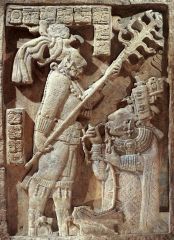
|
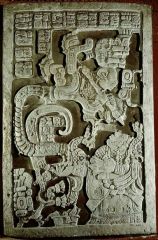
LINTELS 24 &25 BLOODLETTING/VISIONS OF LADY XOC Maya Lord Shield Jaguar is shown with his principle wife, Lady Xoc, who is engaged in the act of bloodletting. She kneels in front of the king, piercing her tongue with a cord of thorns. Her blood is directed into scrolls which are then burned to propitiate spirits. The king holds a torch above her. Lintel 25- Vision of queen is recorded. Over Lady Xoc is an apparition of Yat-Balam, in the form of a warrior emerging from the jaws of a serpent. He was founder of the ruling dynasty of Yaxchilan. Above and surrounding are hieroglyphics which detail and date the sacrifice. The images reinforced political power and ruling of the family. |
|
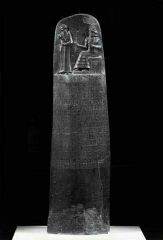
|
STELE OF THE CODE OF HAMMURABI c.1760 BCE Babylonian King was close to and communicating with the god of Justice. -Hierarchical composition (God Shamash is larger than King Hammurabi) king humbled himself before seated god. The rest of the stele is covered in cuneiform establishing authority and compiling laws. Eye for an eye. Portrayed Shamash to show the laws were his wishes. |
|

|
VICTORY STELE OF NARAM-SIN Akkadian C. 2200 BCE Displays hierarchical composition featuring King Naram-sin as the largest & highest figure and the closest to Shamash & Ishtar above. Commemorates a conquest. The triumphant king tramples over the corpses of dead Llubians. Through sacrifices of his enemies more than his own he gets closer to Gods Ishtar and Shamash (differs from Mayans who sacrifice themselves). Gods sanction of his rule and triumph. |
|
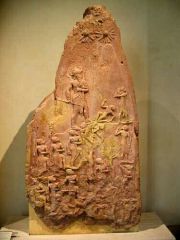
|
VICTORY STELE OF NARAM-SIN Akkadian C. 2200 BCE Displays hierarchical composition featuring King Naram-sin as the largest & highest figure and the closest to Shamash & Ishtar above. Commemorates a conquest. The triumphant king tramples over the corpses of dead Llubians. Through sacrifices of his enemies more than his own he gets closer to Gods Ishtar and Shamash (differs from Mayans who sacrifice themselves). Gods sanction of his rule and triumph. |
|
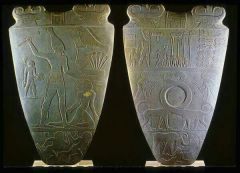
|
PALETTE OF KING NARMER Egyptian C. 3100 BCE Goddess Hathor is shown 4 times as a cow. King Narmer (largest figure) is shown in a victory procession wearing the crown of Lower Egypt. Symbolizes the unification of Upper & Lower Egypt under his rule. Second side shoes King Narmer wearing crown of Upper Egypt before Horus (falcon god) who is delivering Lower Egypt to him. Victory facilitated by Gods |
|
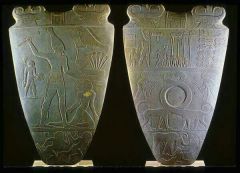
|
PALETTE OF KING NARMER Egyptian C. 3100 BCE Goddess Hathor is shown 4 times as a cow. King Narmer (largest figure) is shown in a victory procession wearing the crown of Lower Egypt. Symbolizes the unification of Upper & Lower Egypt under his rule. Second side shoes King Narmer wearing crown of Upper Egypt before Horus (falcon god) who is delivering Lower Egypt to him. Victory facilitated by Gods |
|

|
PALETTE OF KING NARMER VICTORY STELE OF NARAM-SIN Comparison - depiction of violence - kings both shown crushing enemies - implies triumph and rule sanctioned by Gods - narratives of battle and triumph - both leaders potrayed as semi-devine - made deeds of rulers and their force appear righteous |
|
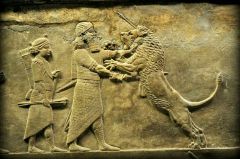
|
ASHURBANIPAL ON FOOT KILLING A LION & LION HUNT ON HORSEBACK Assyrian c. 645-635 BCE King Ashurbanipal is shown driving his spear down the throat of an attacking lion. Also shown finishing off lion in close range by sword. Narrative art. Killing lions symbolized kings role as protector against savagery. Inspired by Gilgamesh. |
|
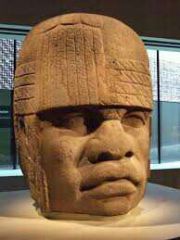
|
COLOSSAL HEAD Olmec Scholars believe they represented kings and were used to mark territorial boundaries. Carved using copper and stone tools. |
|

|
LAMASSU Assyrian c. 883-720 BCE Lamassus were placed on either sides of main entrances to their palaces. They were composite images depicting a man's head on the body of a winged bull. The zoomorphic combination symbolized intelligence & cunning of a human like god combined with the power of an animal. They were intended as supernatural guardians/ warded off evil. Also intimidated human visitors. - functioned as political propaganda reinforcing leaders as dominant and controlling - crown with 2 horns: king - crown with 3 horns: god |
|
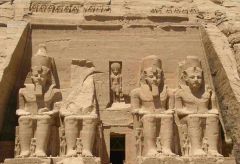
|
MORTUARY TEMPLE OF RAMSES II Egyptian C. 1279-1213 BCE Proclaimed Ramses II's political dominion over Nubia. Asserts his divinity. Inside are eight statues of Osiris depicted with the face of Ramses II. Carved into rock of a cliff overlooking the Nile of Abu Simbel. Depicts Ramses II four times composed, hands palms down on his thighs, staring at the river. His queen Nerfititi and family were depicted much smaller, standing at between his legs. At the center is the god Horus (falcon headed). |
|

|
MORTUARY TEMPLE OF RAMSES II Egyptian C. 1279-1213 BCE Proclaimed Ramses II's political dominion over Nubia. Asserts his divinity. Inside are eight statues of Osiris depicted with the face of Ramses II. Carved into rock of a cliff overlooking the Nile of Abu Simbel. Depicts Ramses II four times composed, hands palms down on his thighs, staring at the river. His queen Nerfititi and family were depicted much smaller, standing at between his legs. At the center is the god Horus (falcon headed). |
|

|
JUDGEMENT OF OSIRIS Egyptian C. 1280 BCE Transition into afterlife graphically depicted on a papyrus scroll. Testing the nature of a person's conduct while they were living. Symbolic weighing of the heart in a balance. At the left. Hunefer is conducted to the balance by Anubis. Thoth records the outcome. Hunefer at the right has been declared true-of-voice. If they passed the test their tripartite soul was thought to become eternally at home in the domain of the gods. |
|
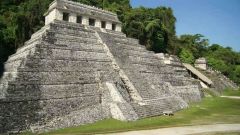
|
TEMPLE OF INSCRIPTIONS Palenque (Mexico) Maya 7th century CE
Lord Pakal laid to rest here to facilitate a successful journey to the afterlife. The tomb was beneath the temple, excavated into the bedrock. 7 layers of represented the 7 layers of Xibalba or the underworld. Pakals tomb lid traced family lineage. Links him to his ancestors and gods. Depicts his cosmic fate.
|
|
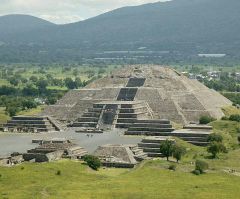
|
TEOTIHUACAN (AERIAL VIEW) PYRAMID OF THE SUN Teotihuacan, Valley of Mexico c. 650 A "ritual theater" on which rituals and political ceremonies were played out, demonstrating mankind's proper place in the cosmic order. Creating this required knowledge of engineering, stone working and astronomy. Marked the site of the emergence of the first ancestors of people who inhabited the site. Contains a vertical Axis Mundi or earth axis symbolically linking the subterranean, earthly and ethereal realms. May house an important tomb since Pyramid of the Moon houses one. |
|
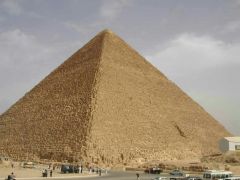
|
GREAT PYRAMIDS OF GIZA Egypt c. 2500 BCE Primary function was to house the mummy of a decreased king such as Kahfre, provide a suitable resting place and house prized possessions. Reliefs traced his family lineage and affiliation with gods. |
|
|
Similarities in art and architecture in Egypt, Mesopotamia and Mesoamerica |
The monumental art and architecture seen in Mesopotamia, Egypt and Mesoamerica provides a testimony to several universals in human nature expressed in the development of state-level societies or civilisations: As urban centers with high population grew larger and more complex, social stratification and specialization of labor became more pronounced. Art and architecture was useful to the elite class as a way of reinforcing their political agenda and spiritual authority. It was used to organize, explain and influence chaotic events in life. They manifest the human hope that through elaborate attempts of propitiation of supernatural forces, events could be shaped in favorable outcomes. |
|
|
Similarities in art and architecture in Egypt, Mesopotamia and Mesoamerica |
The monumental art and architecture seen in Mesopotamia, Egypt and Mesoamerica provides a testimony to several universals in human nature expressed in the development of state-level societies or civilisations: As urban centers with high population grew larger and more complex, social stratification and specialization of labor became more pronounced. Art and architecture was useful to the elite class as a way of reinforcing their political agenda and spiritual authority. It was used to organize, explain and influence chaotic events in life. They manifest the human hope that through elaborate attempts of propitiation of supernatural forces, events could be shaped in favorable outcomes. |
|

|
MENKAURE AND TWO GODDESSES Egypt
Horned goddess is Hathor. Nome goddess. |
|
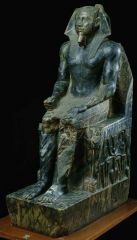
|
SEATED STATUE OF KHAFRE Egypt This was a vehicle for the Ka spirit (Ka spirit required physical vehicle) in order to secure afterlife. Unification of Upper and lower Egypt implied through flowers growing on side of statue. |
|
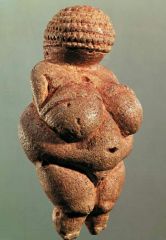
|
WOMAN FROM WILLENDORF Upper paleolithic Made from striking stone against stone. Stylized and full bodied to symbolize an ideal for fertility. Dr Ramachandran's peak shift theory says people prefer images of the body where important features are enhanced. |
|
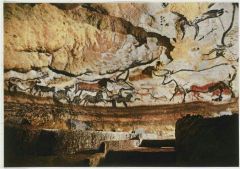
|
AXIAL GALLERY Lascaux Caves, France 1700-1500 BP
commonly hunted animals depicted on cave walls Stylized with bellies emphasized. Could be creation of sacred places (rituals), to control the outcome of a hunt, expression of reverence for nature or tribal identity. |
|

|
AXIAL GALLERY Lascaux Caves, France 1700-1500 BP
commonly hunted animals depicted on cave walls Stylized with bellies emphasized. Could be creation of sacred places (rituals), to control the outcome of a hunt, expression of reverence for nature or tribal identity. |
|
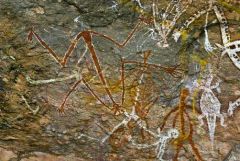
|
AUSTRALIAN ABORIGINE KANGAROO AND MIMI SPIRITS
Mimi paintings are abstract thin Humanlike images of friendly spirits that taught the ancestors how to paint in the x ray style. X ray style paintings were meant to honor the spirit and life force of the animals in the natural environment.
|
|

|
WANDJINA Australian Aborigine May represent spiritual ancestor of a particular tribe. Forces of nature. Connects to the power of the dream time. Pigments with saliva or fat. |
|
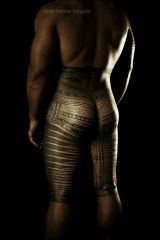
|
SAMOAN TATAU Shows life story /transition into adulthood Shows heritage/ what tribe they belong to/ strength Pe'a is men's Malu is women's |
|
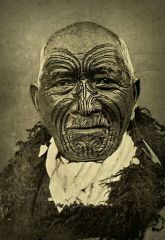
|
MAORI MOKO In new zealand
PUHORO
face tattoo Master carvers, tattoos were engraved |
|
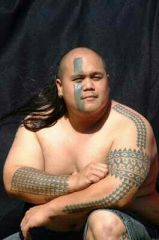
|
HAWAIIAN Kakau Assymetrical |

